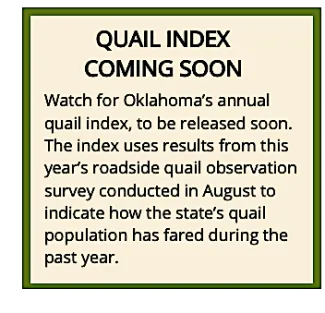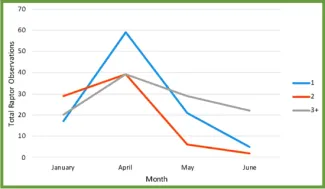Quail Ecology and Management Project Report for August 2021
Provided by Oklahoma Cooperative Fish and Wildlife Research Unit, Oklahoma State University
Some fall raptor surveys are all that remains of the project’s field work, as all field work for the quail component and the invertebrate and seed component has been completed.

For the quail component, Landon Neuman and Samantha Cady continue analyzing data and working on chapters for their Master’s Degree thesis and Doctorate Degree dissertation, respectively. Jennifer Knutson completed and defended her thesis, and is now editing her manuscript in preparation to submit it for publication.
To better understand the impact of hunter harvest on quail populations, researchers have been working on analyses estimating the probability of survival until the onset of breeding for monthly cohorts of bobwhite at Packsaddle and Beaver River Wildlife Management Areas, using data from the previous quail project. These analyses will help define the differential impact of harvest at different times during the quail hunting season.
Researchers have also started compiling the project’s final report.
INVERTEBRATE STUDIES: Researchers submitted revisions to Rangeland Ecology and Management for the manuscript titled “Temporal Variation and Habitat Management Influence Arthropod Prey for Northern Bobwhites.” Researchers have also been preparing revisions to another manuscript focused on arthropod nutrient content for Ecology and Evolution.

Figure 1. Total number of raptor observations per month at Packsaddle WMA for areas with different time-since-fire intervals (one, two, or three-or-more growing seasons post-fire).
RAPTOR STUDIES: In preparation for more raptor sampling this fall, researchers have been examining trends in preference for areas with different time-since-fire intervals (i.e., whether the last fire occurred one, two or three-or-more growing seasons ago in that area) of raptors since the beginning of the year.
Total number of raptor observations peaked in April for all time-since-fire intervals (Figure 1). The most recently burned areas (where only one growing season had passed since the last burn) had the highest total number of raptor observations in April, about 50 percent more than the number of observations in areas where two or three-or-more growing seasons had passed since the last burn. These differences were likely due to the high number of American kestrels observed across all areas in April (83 sightings, or 64 percent of total observations), 44 of which were found in areas where only one growing season had passed since the last burn.
Raptor activity in all areas declined after April, with the largest declines in areas where the last burn happened one or two growing seasons ago.
While American kestrels were not observed after April, Mississippi kites appeared at Packsaddle in May and, for May and June, comprised the majority of the raptors observed in the areas where three or more growing seasons had passed since the last fire.
Hence, raptors appeared most abundant at the study site around the onset of the quail breeding season. But the consequences of these raptor observations for quail predation are unclear, as many of the most-abundant raptors observed at Packsaddle (American kestrels and Mississippi kites) typically prey mostly on insects.